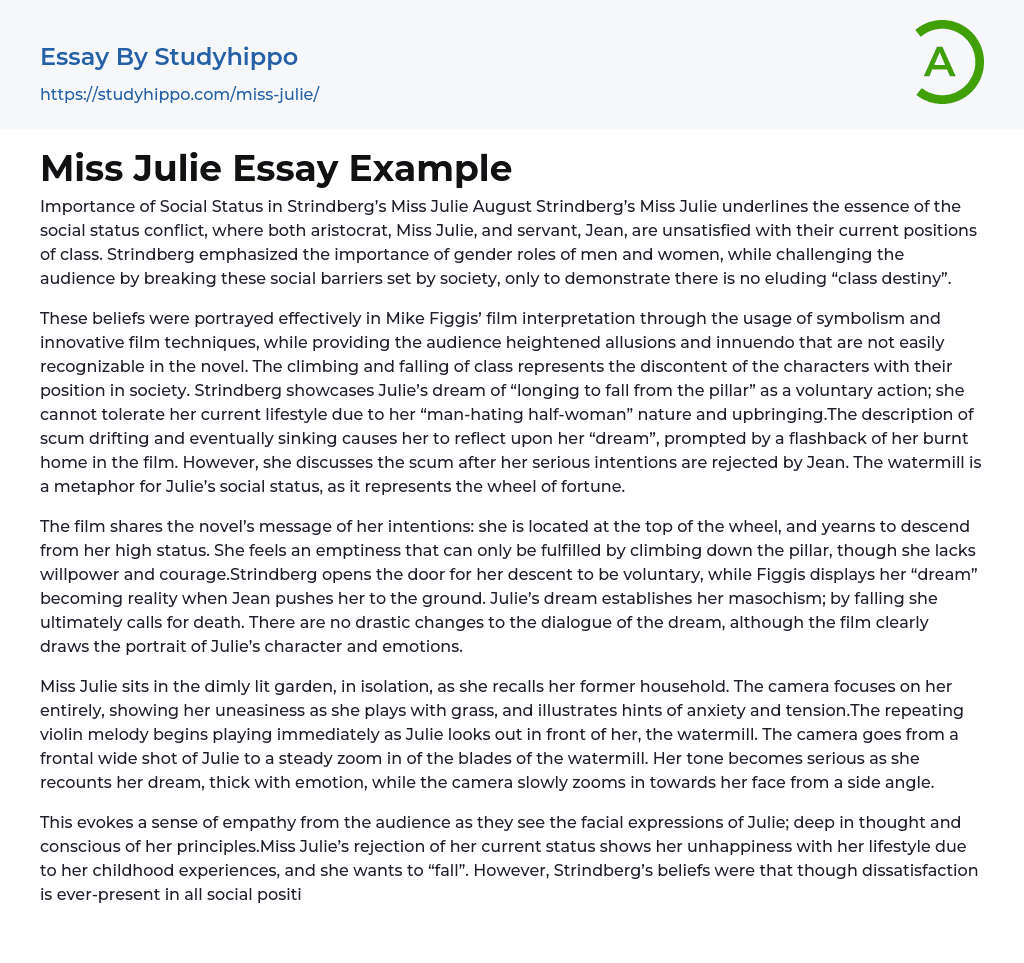Importance of Social Status in Strindberg’s Miss Julie August Strindberg’s Miss Julie underlines the essence of the social status conflict, where both aristocrat, Miss Julie, and servant, Jean, are unsatisfied with their current positions of class. Strindberg emphasized the importance of gender roles of men and women, while challenging the audience by breaking these social barriers set by society, only to demonstrate there is no eluding “class destiny”.
These beliefs were portrayed effectively in Mike Figgis’ film interpretation through the usage of symbolism and innovative film techniques, while providing the audience heightened allusions and innuendo that are not easily recognizable in the novel. The climbing and falling of class represents the discontent of the characters with their position in society. Strindberg showcases Julie’s dream of “longing to fall from the pillar
...” as a voluntary action; she cannot tolerate her current lifestyle due to her “man-hating half-woman” nature and upbringing.The description of scum drifting and eventually sinking causes her to reflect upon her “dream”, prompted by a flashback of her burnt home in the film. However, she discusses the scum after her serious intentions are rejected by Jean. The watermill is a metaphor for Julie’s social status, as it represents the wheel of fortune.
The film shares the novel’s message of her intentions: she is located at the top of the wheel, and yearns to descend from her high status. She feels an emptiness that can only be fulfilled by climbing down the pillar, though she lacks willpower and courage.Strindberg opens the door for her descent to be voluntary, while Figgis displays her “dream” becoming reality when Jean pushes her to the ground. Julie’s dream establishes her
masochism; by falling she ultimately calls for death. There are no drastic changes to the dialogue of the dream, although the film clearly draws the portrait of Julie’s character and emotions.
Miss Julie sits in the dimly lit garden, in isolation, as she recalls her former household. The camera focuses on her entirely, showing her uneasiness as she plays with grass, and illustrates hints of anxiety and tension.The repeating violin melody begins playing immediately as Julie looks out in front of her, the watermill. The camera goes from a frontal wide shot of Julie to a steady zoom in of the blades of the watermill. Her tone becomes serious as she recounts her dream, thick with emotion, while the camera slowly zooms in towards her face from a side angle.
This evokes a sense of empathy from the audience as they see the facial expressions of Julie; deep in thought and conscious of her principles.Miss Julie’s rejection of her current status shows her unhappiness with her lifestyle due to her childhood experiences, and she wants to “fall”. However, Strindberg’s beliefs were that though dissatisfaction is ever-present in all social positions, no can truly escape their “class destiny”. The symbols of the watermill and burnt household help the audience visualize the meaning of Julie’s dream, and the variation between camera angles, lighting and music help provoke further audience response.
- My Dream essays
- My Dream Job essays
- John Locke essays
- 9/11 essays
- A Good Teacher essays
- A Healthy Diet essays
- A Modest Proposal essays
- A&P essays
- Academic Achievement essays
- Achievement essays
- Achieving goals essays
- Admission essays
- Advantages And Disadvantages Of Internet essays
- Alcoholic drinks essays
- Ammonia essays
- Analytical essays
- Ancient Olympic Games essays
- APA essays
- Arabian Peninsula essays
- Argument essays
- Argumentative essays
- Art essays
- Atlantic Ocean essays
- Auto-ethnography essays
- Autobiography essays
- Ballad essays
- Batman essays
- Binge Eating essays
- Black Power Movement essays
- Blogger essays
- Body Mass Index essays
- Book I Want a Wife essays
- Boycott essays
- Breastfeeding essays
- Bulimia Nervosa essays
- Business essays
- Business Process essays
- Canterbury essays
- Carbonate essays
- Catalina de Erauso essays
- Cause and Effect essays
- Cesar Chavez essays
- Character Analysis essays
- Chemical Compound essays
- Chemical Element essays
- Chemical Substance essays
- Cherokee essays
- Cherry essays
- Childhood Obesity essays
- Chlorine essays




